- Home
- Iain M. Banks
Matter Page 7
Matter Read online
Page 7
“Sursamen – an Arithmetic Shellworld orbiting the star Meseriphine in the Tertiary Hulian Spine.” She could still see the glyphs rippling across the surface of her school teaching mat.
She had worked hard to be here, dedicated her life – through study, application, diligence and no small amount of applied psychology – to one day making Sursamen an important part of her existence. In a sense, any Shellworld would have done, but this was the place that had initiated her enchantment, and so for her it had a significance beyond itself. Ironically, the very force of that drive somehow to make herself part of Sursamen’s fate had caused her to overshoot her mark; her ambition had carried her too far, so that now she had oversight of Morthanveld interests within the whole long river-system of stars called the Tertiary Hulian Spine, rather than just the Meseriphine system containing the enigmatic wonder that was Sursamen, with the result that she spent less time here than she would have considered ideal.
The dim green glow of the Gazan-g’ya Crater lit up her body and that of the Grand Zamerin, the gentle light slowly increasing as Sursamen turned and presented more of the vast pockmark of the crater to the rays of the star Meseriphine.
Sursamen collected adjectives the way ordinary planets collected moons. It was Arithmetic, it was Mottled, it was Disputed, it was Multiply Inhabited, it was Multi-million-year Safe, and it was Godded.
Shellworlds themselves had accreted alternative names over the aeons: Shield Worlds, Hollow Worlds, Machine Worlds, Veil Worlds. Slaughter Worlds.
The Shellworlds had been built by a species called the Involucra, or Veil, the best part of a billion years earlier. All were in orbits around stable main-series suns, at varying distances from their star according to the disposition of the system’s naturally formed planets, though usually lying between two and five hundred million kilometres out. Long disused and fallen into disrepair, they had, with their stars, drifted out of their long-ago allotted positions. There had been about four thousand Shellworlds originally; 4096 was the commonly assumed exact number as it was a power of two and therefore – by general though not universal assent – as round a figure as figures ever got. No one really knew for sure, though. You couldn’t ask the builders, the Involucra, as they had disappeared less than a million years after they’d completed the last of the Shellworlds.
The colossal artificial planets had been spaced regularly about the outskirts of the galaxy, forming a dotted net round the great whirlpool of stars. Almost a billion years of gravitational swirling had scattered them seemingly randomly across and through the skies ever since: some had been ejected from the galaxy altogether while others had swung into the centre, some to stay there, some to be flung back out again and some to be swallowed by black holes, but using a decent dynamic star chart, you could feed in the current positions of those which were still extant, backtrack eight hundred million years and see where they had all started out.
That four-thousand-plus figure had been reduced to a little over twelve hundred now, mostly because a species called the Iln had spent several million years destroying the Shellworlds wherever they could find them and nobody had been willing or able to prevent them. Exactly why, nobody was entirely sure and, again, the Iln were not around to ask; they too had vanished from the galactic stage, their only lasting monument a set of vast, slowly expanding debris clouds scattered throughout the galaxy and – where their devastation had been less than complete – Shellworlds that had been shattered and collapsed into barbed and fractured wrecks, shrunken compressed husks of what they had once been.
The Shellworlds were mostly hollow. Each had a solid metallic core fourteen hundred kilometres in diameter. Beyond that, a concentric succession of spherical shells, supported by over a million massive, gently tapering towers never less than fourteen hundred metres in diameter, layered out to the final Surface. Even the material they were made from had remained an enigma – to many of the galaxy’s Involved civilisations at least – for over half a billion years, before its properties were fully worked out. From the start, though, it had been obvious that it was immensely strong and completely opaque to all radiation.
In an Arithmetic Shellworld, the levels were regularly spaced at fourteen-hundred-kilometre intervals. Exponential or Incremental Shellworlds had more levels close to the core and fewer further out as the distance between each successive shell increased according to one of a handful of logarithm-based ratios. Arithmetic Shellworlds invariably held fifteen interior surfaces and were forty-five thousand kilometres in external diameter. Incremental Shellworlds, forming about twelve per cent of the surviving population, varied. The largest class was nearly eighty thousand kilometres across.
They had been machines. In fact, they had all been part of the same vast mechanism. Their hollowness had been filled, or perhaps had been going to be filled (again, nobody could be certain this had actually been done), with some sort of exotic superfluid, turning each of them into a colossal field projector, with the aim, when they were all working in concert, of throwing a force field or shield round the entire galaxy.
Precisely why this had been thought necessary or even desirable was also unknown, though speculation on the matter had preoccupied scholars and experts over the aeons.
With their original builders gone, the people who had attacked the worlds seemingly also permanently missing and the fabled superfluid equally absent, leaving those vast internal spaces linked by the supporting Towers – themselves mostly hollow, though containing twisted webs of structurally reinforcing material, and punctured with portals of various sizes giving access to each of the levels – it had taken almost no time at all for a variety of enterprising species to work out that a derelict Shellworld would make a vast, ready-made and near-invulnerable habitat, after just a few relatively minor modifications.
Gases, fluids – especially water – and solids could be pumped or carried in to fill all or some of the spaces between the levels, and artificial interior “stars” might be fashioned to hang from the ceilings of each level like gigantic lamps. The various venturesome species set about exploring the Shellworlds closest to them, and almost immediately encountered the problem that would bedevil, frustrate and delay the development of the worlds profoundly for the next few million years and, intermittently, beyond; the Shellworlds could be deadly.
It remained unclear to this day whether the defence mechanisms that kept killing the explorers and destroying their ships had been left behind by the worlds’ original builders or those who appeared to have dedicated their entire existence to the task of destroying the great artefacts, but whether it had been the Veil or the Iln – or, as it was now generally agreed, both – who had left this lethal legacy behind, the principal factor limiting the use of the Shellworlds as living spaces was simply the difficulty of making them safe.
Many people died developing the techniques by which a Shellworld might be so secured, and the same lessons generally had to be learned afresh by each competing civilisation, because the power and influence which accrued to a grouping capable of successful Shellworld exploitation meant that such techniques remained fiercely guarded secrets. It had taken an Altruist civilisation – exasperated and appalled at such a selfish waste of life – to come along, develop some of the techniques, steal others and then broadcast the whole to everybody else.
They had, of course, been roundly vilified for such unsporting behaviour. Nevertheless, their actions and stance had, in time, been ratified and even rewarded by various galactic bodies, and the Culture, although far remote in time from these now long-Sublimed people, had always claimed a sort of kinship by example with them.
The civilisations which specialised in making Shellworlds safe and who effectively took part-ownership of their interiors became known as Conducers. Sursamen was unusual in that two species – the Oct (who claimed direct descent from the long-departed Involucra and so also called themselves the Inheritors) and the Aultridia (a species with what might be termed a poorly perceived provenance) – had arrive
d at the same time and begun their work. It had also been unusual in that neither species ever got a decisive upper hand in the ensuing conflict which, in the only positive aspect of the dispute, at least remained localised to Sursamen. In time the situation within the world had been formalised when the two species were awarded joint protective custody of Sursamen’s access Towers by the then newly formed Galactic General Council, though, importantly, without any stipulation that the two could not contend for increased influence in the future.
The Nariscene were granted full inhabitory rights to the planet’s Surface and overall control of the world, formalising their long-held claim to it, though even they had to defer ultimately to the Morthanveld, in whose volume of influence the system and the world lay.
So Sursamen had been colonised, making it Inhabited, and by a variety of species, hence the Multiply- prefix. The holes in the supporting Towers that might have let gases or liquids vent to lower levels were sealed; some effectively permanently, others with lock complexes that permitted safe entry and exit, while transport mechanisms were installed inside the great hollow Towers to allow movement between the various levels and to and from the Surface. Material in gaseous, liquid and solid form had been moved in over the many millions of years of the planet’s occupation, and beings, peoples, species, species groups and whole ecosystems had been imported by the Oct and the Aultridia, usually for a consideration of some sort or another, sometimes at the behest of the peoples concerned, more often at the request of others.
Interior stars had been emplaced; these were thermonuclear power sources like tiny suns, but with the useful distinction of being anti-gravitative, so that they pressed upwards against the ceiling above any given level. They subdivided into Fixstars and Rollstars, the former stationary, the latter moving across the skies on predetermined routes and on regular, if sometimes – when there were many, of different periodicities – complicated schedules.
The deaths continued, too; long after a given Shellworld had been apparently de-weaponed and made safe, hidden defence systems could wake up centuries, millennia and decieons later, resulting in gigadeaths, teradeaths, effective civicides and near-extinctions as interior stars fell, levels were flooded from above or drained – often with the result that oceans met interior stars, resulting in clouds of plasma and superheated steam – atmospheres were infested by unknown wide-species-spectra pathogens or were turned inexorably into poisonous environments by unseen mechanisms nobody could stop, or intense bursts of gamma radiation emanating from the floor/ceiling structure itself flooded either individual levels or the whole world.
These were the events that gave them the name Slaughter Worlds. At the point that Director General Shoum gazed down upon the dark, colour-spotted face of Sursamen, no mass deaths had been caused by the Shellworlds themselves for nearly four million years, so the term Slaughter World had long since slipped into disuse, save amongst those cultures with exceptionally long memories.
Nevertheless, on a grand enough scale the morbidity of any habitat type could be roughly judged by the proportion that had become Dra’Azon Planets of the Dead over time. Planets of the Dead were preserved, forbidden monuments to globe-encompassing carnage and destruction which were overseen – and usually kept in a pristine, just post-catastrophe state – by the Dra’Azon, one of the galactic community’s more reclusive semi-Sublimed Elder civilisations with attributes and powers sufficiently close to god-like for the distinction to be irrelevant. Out of the four-thousand-plus Shellworlds originally existing and the 1332 unequivocally remaining – 110 in a collapsed state – fully eighty-six were Planets of the Dead. This was generally agreed to be an alarmingly high proportion, all things considered.
Even some of the Shellworlds lacking the morbid interest of the Dra’Azon had a kind of semi-divine investment. There was a species called the Xinthian Tensile Aeronathaurs, an Airworld people of enormous antiquity and – according to fable – once of enormous power. They were the second or third largest airborne species in the galaxy and, for reasons known solely to themselves, sometimes one of them would take up solitary residence in the machine core of a Shellworld. Though once widespread and common, the Xinthia had become a rare species and were regarded as Developmentally Inherently, Pervasively and Permanently Senile – in the unforgiving language of Galactic taxonomy – by those who bothered to concern themselves with such anachronisms at all.
For as long as anybody could remember, almost all the Xinthia had been gathered together in one place; a necklace of Airworlds ringing the star Chone in the Lesser Yattlian Spray. Only a dozen or so were known to exist anywhere else, and seemingly they were all at the cores of individual Shellworlds. These Xinthians were presumed to have been exiled for some transgression, or to be solitude-craving hermits. Presumption was all anybody had to go on here too, as even though the Xinthia, unlike the long-departed Veil or Iln, were still around to ask, they were, even by the standards of the galaxy’s Taciturn cultures, quite determinedly uncommunicative.
Hence the Godded part of Sursamen’s full description; there was a Xinthian Tensile Aeronathaur at its core, called by some of the world’s inhabitants the WorldGod.
Invariably inside the great worlds and sometimes on their exteriors, the shells were adorned with massive vanes, whorls, ridges, bulges and bowls of the same material that made up both the levels themselves and the supporting Towers. Where such structures appeared on the Surface of a Shellworld, the bowl-shaped features had usually been filled with mixtures of atmospheres, oceans and/or terrain suitable for one or more of the many Involved species; the shallower examples of these – somewhat perversely called Craters – were roofed, the deeper usually not.
Sursamen was one such example of a Mottled Shellworld. Most of its Surface was smooth, dark grey and dusty – all the result of being lightly covered with nearly an aeon’s worth of impact debris after systemic and galactic bodies of various compositions, sizes and relative velocities had impacted with that unforgiving, adamantine skin. About fifteen per cent of its external shell was pocked with the covered and open bowls people called Craters and it was the greeny-blue reflected light of one of those, the Gazan-g’ya Crater, that shone through the porthole in the transit facility and gently lit up the bodies of the Grand Zamerin and the director general.
“You are always glad to arrive, to see Sursamen, or any Shellworld, are you not?” Utli asked Shoum.
“Of course,” she said, turning to him a little.
“Whereas, personally,” the Grand Zamerin said, swivelling away from the view, “it’s only duty keeps me here; I’m always relieved to see the back of the place.” There was a tiny warble and one of his eye stalks flicked briefly over to look at what appeared to be a jewel embedded in his thorax. “Which we’re informed occurs very shortly; our ship is ready.”
Shoum’s comms torque woke to tell her the same thing, then went back to its privacy setting.
“Relieved? Really?” the director general asked as they floated back through the web towards their respective entourages and the docking chutes that gave access to the ships.
“We shall never understand why you are not, Shoum. These are still dangerous places.”
“It’s been a very long time since any Shellworld turned on its inhabitants, Utli.”
“Ah, but still; the intervals, dear DG.”
The Grand Zamerin was referring to the distribution of Shellworld-induced mass die-offs through time. Plotted out, they implied only a slow dying away of such titanic murderousness, not yet a final end. The graphed shape of attacks approached zero, but did so along a curve that implied there might be one or two more yet to come, probably some time in the next few thousand years. If, of course, that was really the way these things worked. The implied threat of future cataclysms might be the result of coincidence, nothing more.
“Well then,” Shoum said, “to be blunt, we would have to hope it does not happen during our tenure, or if does, it does not happen in Sursamen.”
<
br /> “It’s just a matter of time,” the Grand Zamerin told her gloomily. “These things turn killer, or disappear. And nobody knows why.”
“Yet, Utli,” the director general said, signalling mischievousness, “do you not find it in any sense romantic somehow – even in a sense reassuring – that there are still such mysteries and imponderables in our polished, cultivated times?”
“No,” the Grand Zamerin said emphatically, expelling an emission named Doubting the sanity of one’s companion, with barely a trace of humour.
“Not even in the abstract?”
“Not even in the abstract.”
“Oh, well. Still, I wouldn’t worry, if I were you,” Shoum told Utaltifuhl as they approached their attendants. “I suspect Sursamen will still be here when you get back.”
“You think its disappearance is unlikely?” Utli said, now expressing mock seriousness.
“Vanishingly,” Shoum said, but the joke didn’t translate.
“Indeed. And of course. However, it has struck us that so wonderful and enjoyable is the life we lead that a disaster of equal but opposite proportions must always be a threat. The higher you build your Tower, the more tempting a target for fate it becomes.”
“Well, at least you are vacating your Tower for the next year. I trust the trip home is rewarding and I shall look forward with pleasure to seeing you again, Grand Zamerin.”
“And I you, Director General,” Utaltifuhl told her, and performed the most respectful and delicate of formal mandible-nips on her outstretched maniple spine. Shoum blushed appropriately.
They had reached their respective entourages and a giant window that looked out the other side of the transit facility, to a small fleet of docked ships. Utaltifuhl looked out at the star craft and emoted dubiety. “Hmm,” he said. “And interstellar travel is also not without its risks.”
5. Platform
Djan Seriy Anaplian, who had been born a princess of the house of Hausk, a dynasty from a wide-spectrum pan-human species lately from a median level of the Shellworld Sursamen and whose middle name basically meant fit-to-be-married-to-a-prince, stood alone on a tall cliff looking out over a rust desert deep within the continent of Lalance on the planet Prasadal. A strong wind lashed at her long coat and tore at her clothes. She still wore her dark, wide-brimmed hat and its stiff material was caught and tugged at by the gusting wind as though it was trying to tear it off her head. The hat, secured by well-tied ribbons, was unlikely to come off, but it meant that the wind made her head shake and nod and jerk as though with palsy. The wind carried dust and sand in small dry flurries that came beating up from the desert floor beneath and curling over the serrated edge of the cliff, stinging her cheeks where they were exposed between the scarf that covered her mouth and nose and the goggles that protected her eyes.

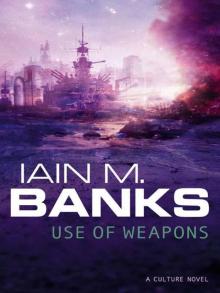 Use of Weapons
Use of Weapons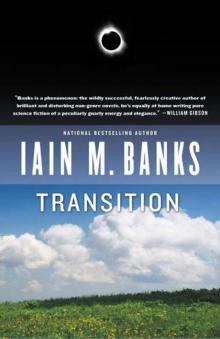 Transition
Transition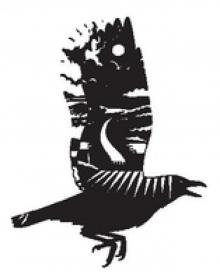 The Crow Road
The Crow Road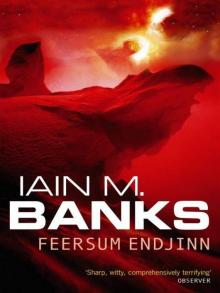 Feersum Endjinn
Feersum Endjinn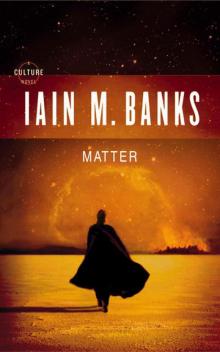 Matter
Matter Surface Detail
Surface Detail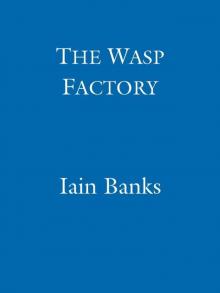 The Wasp Factory
The Wasp Factory Consider Phlebas
Consider Phlebas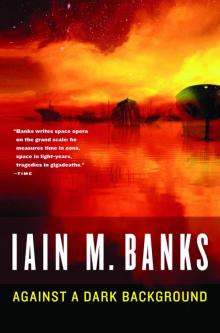 Against a Dark Background
Against a Dark Background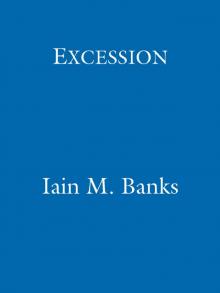 Excession
Excession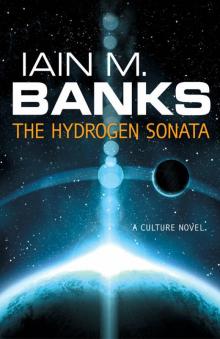 The Hydrogen Sonata
The Hydrogen Sonata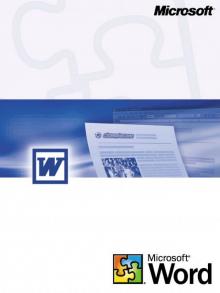 The Algebraist
The Algebraist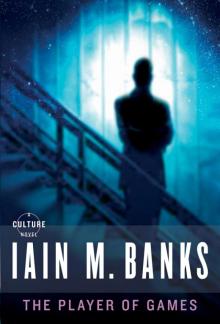 The Player of Games
The Player of Games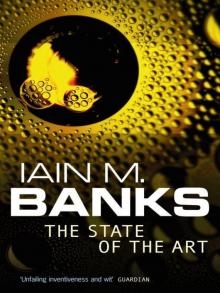 The State of the Art
The State of the Art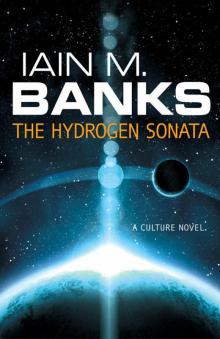 The Hydrogen Sonata c-10
The Hydrogen Sonata c-10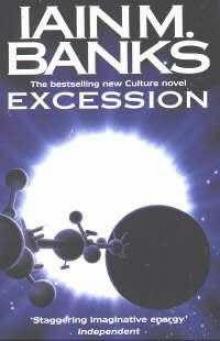 Excession c-5
Excession c-5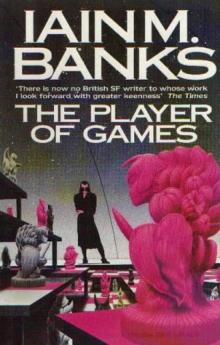 The Player of Games c-2
The Player of Games c-2 Matter c-8
Matter c-8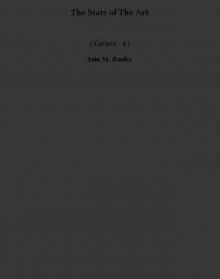 The State of The Art c-4
The State of The Art c-4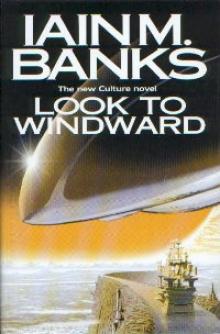 Look to Windward c-7
Look to Windward c-7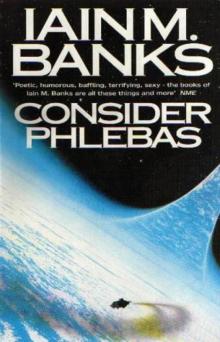 Consider Phlebas c-1
Consider Phlebas c-1